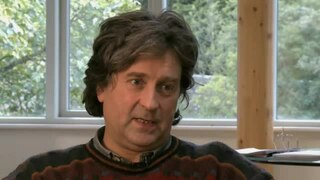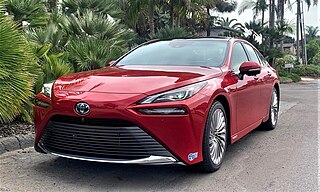
A fuel cell is an electrochemical cell that converts the chemical energy of a fuel and an oxidizing agent into electricity through a pair of redox reactions. Fuel cells are different from most batteries in requiring a continuous source of fuel and oxygen to sustain the chemical reaction, whereas in a battery the chemical energy usually comes from substances that are already present in the battery. Fuel cells can produce electricity continuously for as long as fuel and oxygen are supplied.
A hydrogen vehicle is a vehicle that uses hydrogen fuel for motive power. Hydrogen vehicles include hydrogen-fueled space rockets, as well as ships and aircraft. Power is generated by converting the chemical energy of hydrogen to mechanical energy, either by reacting hydrogen with oxygen in a fuel cell to power electric motors or, less commonly, by burning hydrogen in an internal combustion engine.

fuel cell vehicle (FCV) or fuel cell electric vehicle (FCEV) is an electric vehicle that uses a fuel cell, sometimes in combination with a small battery or supercapacitor, to power its onboard electric motor. Fuel cells in vehicles generate electricity generally using oxygen from the air and compressed hydrogen. Most fuel cell vehicles are classified as zero-emissions vehicles that emit only water and heat. As compared with internal combustion vehicles, hydrogen vehicles centralize pollutants at the site of the hydrogen production, where hydrogen is typically derived from reformed natural gas. Transporting and storing hydrogen may also create pollutants.

A hydrogen station is a storage or filling station for hydrogen. The hydrogen is dispensed by weight. There are two filling pressures in common use. H70 or 700 bar, and the older standard H35 or 350 bar.

The Honda EV Plus was the first battery electric vehicle from a major automaker that did not use lead acid batteries. Roughly 340 EV Plus models were produced and released. Production of the EV Plus was discontinued in 1999 after Honda announced the release of its first hybrid electric vehicle, the Honda Insight.

The Morgan LIFEcar was originally a fuel cell-powered electric vehicle project undertaken by Morgan Motor Company and startup company Riversimple. The goal of LIFEcar was a sports car that would be environmentally responsible, and deliver impressive performance. Research and development was backed by QinetiQ, a British defence technology firm, as well as several universities, including Cranfield University and the University of Oxford, and government grants. The project abandoned the fuel-cell architecture in favour of a hybrid approach with a 15-mile electric range.
Hydrogen technologies are technologies that relate to the production and use of hydrogen as a part hydrogen economy. Hydrogen technologies are applicable for many uses.

A hydrogen-powered aircraft is an aeroplane that uses hydrogen fuel as a power source. Hydrogen can either be burned in a jet engine or another kind of internal combustion engine, or can be used to power a fuel cell to generate electricity to power a propeller. Unlike most aircraft, which store fuel in the wings, hydrogen-powered aircraft are usually designed with the hydrogen fuel tanks inside the fuselage.

The Toyota FCHV is a current hybrid hydrogen fuel cell vehicle development programme of the Toyota Motor Corporation, which was leased to a limited number of drivers in the United States and Japan beginning in 2002. "FCHV" stands for "Fuel Cell Hybrid Vehicle". A number of prototypes have been produced, up to the latest FCHV-adv ("advanced").

Eco-Runner Team Delft is a Delft University of Technology student team, aiming to promote a sustainable future by building the world's most efficient hydrogen-powered car. At the end of the year, the team participates in the Shell Eco-marathon competition in order to assess the efficiency of the vehicle. Eco-Runner Team Delft won the competition in 2015 and 2022. In the competition there are two vehicle classes: Prototype and UrbanConcept. For years Eco-Runner Team Delft participated in the Shell Eco-marathon Prototype class competition where the goal is to cover a certain distance with the least amount of hydrogen. In the year 2019–2020, the team has decided to compete in a different competition; the Urban Concept class. This challenge offers the team the opportunity to design and build an efficient hydrogen-powered vehicle that is closer in appearance to modern city cars.
The Honda FCX is a family of hydrogen fuel cell automobiles manufactured by Honda.

Hugo Ronald Alan Spowers is a British entrepreneur-engineer who co-ordinated the development of the Morgan LIFEcar sports car project that was launched at the Geneva Motor Show in March 2008, and the Riversimple Urban Car.

The Mazda Premacy Hydrogen RE Hybrid or Mazda5 Hydrogen RE Hybrid was a hydrogen powered hybrid car produced by Mazda. Later models were also called the Mazda Hydrogen RE Plug in Hybrid. The first car was unveiled in 2005, with an improved version shown at the 2007 Tokyo Motor Show. Mazda planned for the car to enter production and leased a few cars to end users in 2009 in 2010.

The Riversimple Urban Car is a conceptual open source hydrogen fuel cell vehicle that was proposed by Hugo Spowers' company, Riversimple, in 2009. Their latest model, the Rasa, was unveiled on 17 February 2016.

The Toyota Mirai is a mid-size hydrogen fuel cell vehicle (FCV) manufactured by Toyota, and is one of the first FCV automobiles to be mass-produced and sold commercially. The Mirai was unveiled at the November 2014 Los Angeles Auto Show. As of December 2021, global sales totaled 17,940 units; the top-selling markets were the U.S. with 9,274 units, Japan with 6,618 and the rest of the world with 2,048.

The Hyundai ix35 FCEV or Tucson FCEV is a hydrogen fuel cell electric vehicle developed by Hyundai. The model is a left-hand drive only conversion to the SUV platform it is based on and was the first of its type to be mass-produced and sold commercially in the world. Different versions are known, the previous version was based on the Hyundai Tucson FCEV, and the upcoming model is based on the current ix35 FCEV. The first generation was introduced in 2001, with the Hyundai Santa Fe FCEV, and had a range of 100 miles (160 km), with a top speed of 78 mph (126 km/h).

The Hyundai Nexo is a hydrogen fuel cell powered crossover SUV that was revealed at the 2018 Consumer Electronics Show on January 8, 2018. Replacing the Hyundai Tucson FCEV, the Nexo is the flagship for Hyundai's "eco car" portfolio.
There are numerous versions of vehicle propulsion systems. Many of those came into fruition due to need for cleaner vehicles. Each of them might have many abbreviations and some might be misleading. This article explains shortly what defines them.

The British Rail Class 799 are tri-mode multiple units prototype adapted from Class 319 electric multiple units (319001/382). The existing 25 kV AC and 750 V DC equipment has been retained with a hydrogen fuel cell added, currently taking up one of the carriages.















